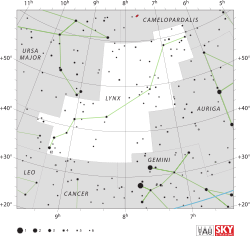16 Lyncis
 | |
| Observation data Epoch J2000 Equinox J2000 | |
|---|---|
| Constellation | Lynx |
| Right ascension | 06h 57m 37.10709s[1] |
| Declination | +45° 05′ 38.7404″[1] |
| Apparent magnitude (V) | 4.90[2] |
| Characteristics | |
| Spectral type | A2Vn[2] |
| B−V color index | 0.04[2] |
| Variable type | suspected |
| Astrometry | |
| Radial velocity (Rv) | −11.90±1[3] km/s |
| Proper motion (μ) | RA: −21.52±0.27[1] mas/yr Dec.: −3.12±0.17[1] mas/yr |
| Parallax (π) | 13.54 ± 0.23[1] mas |
| Distance | 241 ± 4 ly (74 ± 1 pc) |
| Absolute magnitude (MV) | 0.56[4] |
| Details[5] | |
| Mass | 2.38 M☉ |
| Luminosity | 56[4] L☉ |
| Surface gravity (log g) | 4.02 cgs |
| Temperature | 10,395±353 K |
| Rotational velocity (v sin i) | 229 km/s |
| Age | 181 Myr |
| Other designations | |
| Database references | |
| SIMBAD | data |
16 Lyncis (16 Lyn) is the 4th magnitude and brightest star in the constellation Lynx. Located approximately 74 parsecs (240 ly) distant. It was also known as Psi-10 Aurigae (ψ10 Aur).
It is a A-type main-sequence star (A2Vn),[2] a star that is currently fusing its core hydrogen. The star is suspected of being slightly variable, but this has not been confirmed.[6]
References
- 1 2 3 4 5 Van Leeuwen, F. (2007). "Validation of the new Hipparcos reduction". Astronomy and Astrophysics. 474 (2): 653–664. arXiv:0708.1752. Bibcode:2007A&A...474..653V. doi:10.1051/0004-6361:20078357.
- 1 2 3 4 "Psi10 Aurigae". SIMBAD Astronomical Database. Centre de Données astronomiques de Strasbourg. Retrieved 11 October 2014.
- ↑ Gontcharov, G. A. (November 2006). "Pulkovo Compilation of Radial Velocities for 35 495 Hipparcos stars in a common system". Astronomy Letters. 32 (11): 759–771. arXiv:1606.08053. Bibcode:2006AstL...32..759G. doi:10.1134/S1063773706110065.
- 1 2 Anderson, E.; Francis, Ch. (2012), "XHIP: An extended hipparcos compilation", Astronomy Letters, 38 (5): 331, arXiv:1108.4971, Bibcode:2012AstL...38..331A, doi:10.1134/S1063773712050015.
- ↑ David, Trevor J.; Hillenbrand, Lynne A. (2015), "The Ages of Early-Type Stars: Strömgren Photometric Methods Calibrated, Validated, Tested, and Applied to Hosts and Prospective Hosts of Directly Imaged Exoplanets", The Astrophysical Journal, 804 (2): 146, arXiv:1501.03154, Bibcode:2015ApJ...804..146D, doi:10.1088/0004-637X/804/2/146.
- ↑ VSX (18 January 2010). "NSV 3293". AAVSO Website. American Association of Variable Star Observers. Retrieved 11 October 2014.
This article is issued from
Wikipedia.
The text is licensed under Creative Commons - Attribution - Sharealike.
Additional terms may apply for the media files.